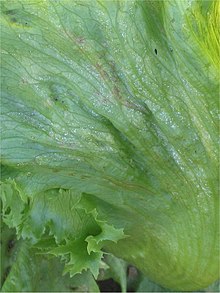Bremia lactucae
| Bremia lactucae | |
|---|---|
 |
|
| Iceberg lettuce infected with Bremia lactucae | |
| Scientific classification | |
| Domain: | Eukaryota |
| (unranked): | SAR |
| Superphylum: | Heterokonta |
| Class: | Oomycetes |
| Order: | Peronosporales |
| Family: | Peronosporaceae |
| Genus: | Bremia |
| Species: | B. lactucae |
| Binomial name | |
|
Bremia lactucae Regel, Bot. Ztg.: 666 (1843) |
|
| Synonyms | |
|
Botrytis gangliformis Berk. [as 'ganglioniformis'], (1846) |
|
Botrytis gangliformis Berk. [as 'ganglioniformis'], (1846)
Bremia centaureae Syd., (1923)
Bremia gangliformis (Berk.) C.G. Shaw, (1949)
Peronospora gangliformis Tul. [as 'ganglioniformis'], (1854)
Peronospora gangliformis (Berk.) de Bary, (1863)
Bremia lactucae is a plant pathogen. This microorganism causes a disease of lettuce (Lactuca sativa) denominated as downy mildew. Some other strains can be found on 36 genera of Asteraceae including Senecio and Sonchus. Experiments using sporangia from hosts do not infect lettuce and it is concluded that the fungus exists as a quantity of host-specific strains (formae speciales). Wild species, such as Lactuca serriola, or varieties of Lactuca can hold strains that infect lettuce, but these pathogens are not sufficiently common to infect seriously the plant.
The damage to caused by Bremia to lettuce may not in itself be serious, but infected plants are susceptible to secondary infection by the more severe mould, Botrytis cinerea. The plant can suffer systemic infections. Metalaxyl is effective against this microorganism.
...
Wikipedia
